Abstract
This report presents the activities and outcomes of an educational project aimed at promoting sustainable food awareness among high-school students in Italy through the active contributions from young researchers, profit partners and school educators. The project involved two final-year classes—one from a scientific lyceum and one from a technical chemistry institute—and integrated theoretical lessons, laboratory activities, and experiential learning focused on planetary boundaries, sustainable diets, and alternative proteins such as from algae and insects. To assess the impact of the project, pre- and post-intervention questionnaires were administered and are here discussed. The intervention significantly enhanced the students’ cognitive and affective engagement both during the sessions and in the immediate aftermath, as evidenced by elevated levels of satisfaction and retention of key concepts. Overall, the project fostered great environmental awareness and openness to sustainable food choices, demonstrating the potential of targeted hands-on educational programs to influence both attitudes and behaviours in younger generations of western high-income countries. The project serves as a replicable model of a transdisciplinary approach for integrating Education for Sustainable Development (ESD) and education for Planetary Health into secondary school curricula.
1. Introduction
Over the past decades, growing awareness of the environmental, social, and economic consequences of food production has sparked increasing interest in sustainable food systems. The United Nations’ 2030 Agenda for Sustainable Development calls for a transformation of these systems to ensure food security, reduce ecological degradation, and promote health and well-being [1]. Several Sustainable Development Goals (SDGs) are directly or indirectly connected to food, including SDG 2 (Zero Hunger), SDG 3 (Good Health and Well-being), SDG 12 (Responsible Consumption and Production), and SDG 13 (Climate Action) [2,3].
In response to urgent global challenges such as climate change, biodiversity loss, and social inequality, education emerges as a powerful driver of change [4,5,6]. It plays a central role in achieving the SDGs by equipping learners with the knowledge, values, and skills needed to navigate complex and uncertain contexts [4,7,8]. UNESCO emphasizes that Education for Sustainable Development (ESD) empowers individuals to make informed decisions and take responsible actions for environmental integrity, economic viability, and social justice [9].
The recent literature highlights that sustainability competencies go beyond content knowledge, encompassing attitudes, values, and the capacity to act [10,11,12]. A 2024 scoping review by Sposab & Rieckmann [13] explores how these competencies are conceptualized and cultivated in secondary education. Their analysis of over two decades of research identifies two dominant approaches: one focused on transversal competencies—such as systems thinking, critical thinking, and action competence—and another based on integrated frameworks that combine cognitive, emotional, and behavioural dimensions. The review also points to a geographic imbalance in the literature, with a concentration of studies from countries like Germany, Sweden, and Spain, and a notable lack of contributions from others, including Italy.
Educational institutions are increasingly embedding sustainability and planetary health into their curricula to empower students to collaborate across disciplines and co-create solutions to environmental challenges across the world [14,15,16,17] and in Italy [17,18,19,20]. However, translating sustainability knowledge into meaningful action remains a challenge. There is a growing call for experiential, interdisciplinary, and impactful educational initiatives [2,12].
Thus, recognizing that unfamiliarity and limited knowledge are key barriers to the acceptance of novel foods, while perceptions of health benefits and environmental sustainability act as drivers [21], the Italian project “Cosa cuciniamo domani? Esperienze che alimentano il futuro” (What shall we cook tomorrow? Experiences that nourish the future), funded by Fondazione Cariverona and co-funded by Università Politecnica delle Marche (UNIVPM) and Istituto di Istruzione Superiore ‘Volterra Elia’ (IISVE), was designed to answer this challenging call. It engaged high-school students in a hands-on, curiosity-driven exploration of sustainable food practices. Through labs, seminars, and collaborative activities, students explored topics such as planetary boundaries and health [7,8], alternative protein sources (e.g., algae and insects) [22], and the environmental impact of dietary choices [23]. The initiative is presented as a scalable and replicable model that can be adapted across schools, cities, and communities. Grounded in pedagogical approaches that promote awareness, agency, and transformative change [4], the project demonstrated how participatory, decision-oriented, and collaborative learning experiences can effectively nurture sustainability competencies, including critical thinking and collaboration.
2. Educational Approach
2.1. Participants and Context
This study involved a total of 46 students divided into two final-year high-school classes in Ancona (AN, Italy): one from a scientific lyceum (27 students) and one from a technical institute specializing in chemistry (19 students). The students participated in the educational project “Cosa cuciniamo domani? Esperienze che alimentano il futuro”, which aimed to promote awareness and skills related to sustainable food systems, alternative proteins, and planetary boundaries. The project was 14 months long and structured in 6 Actions. Interdisciplinary collaboration was achieved by UNIVPM, partner schools, profit entities. The projects methodological framework involved hands-on experimentation, participatory education, civic dissemination.
2.2. Questionnaires
A structured questionnaire was administered to students both before and after the project to evaluate its short-term impact. However, since the participants were in their final year and completed their diploma exams at the end of the project, it was not possible to conduct a follow-up survey to assess its long-term effects. The questionnaires are reported in detail in Table 1 and Table 2. The questionnaires included both closed and open-ended questions addressing: (i) dietary habits, (ii) frequency o2423f meat consumption, (iii) prior experience with algae- and insect-based foods, (iv) awareness of sustainability-related concepts. The pre-project questionnaire was distributed at the beginning of the project, before any knowledge or information was transferred to the students. The final questionnaire was completed after the conclusion of all educational activities. The data were collected anonymously, and participants were not required to answer all questions. On the day the questionnaires were distributed, not all students were present. As a result, the number of IDs recorded does not accurately reflect the actual number of students in the two classes, as shown in the Supplementary Materials. Data were analysed using descriptive statistics and chi-square tests to assess significant changes in the students’ responses.

Table 1.
Initial questionnaire. The questionnaire was distributed at the beginning of the project and included questions regarding eating habits and general knowledge about sustainability-related concepts.

Table 2.
Final questionnaire. The questionnaire was distributed at the end of the project and included questions regarding eating habits and general knowledge about sustainability-related concepts. Further, it evaluated any changes in eating habits directly due to the project.
2.3. Teaching Activities
The educational program included a combination of frontal lectures conducted both at school and at the university. School-based lessons served as an introductory phase, providing students with the essential background and a general overview of the topics that would later be explored in greater depth during the university seminars and laboratory sessions. Each lecture, both at school and university, had a duration of approximately one hour.
The initial lessons delivered in the schools were the following:
- A Great Food Transition;
- The Light Reactions of Photosynthesis;
- Calvin Cycle and Life Based on Carbon;
- Planetary Boundaries and Novel Food;
- Insects and Nutrition: An Eco-Sustainable Gamble.
Following this introductory phase, students participated in a series of university-based seminars held by researchers and academic staff. These seminars were focused on topics related to biodiversity, environmental sustainability, food analysis, and novel food sources, including algae and insects. One seminar specifically addressed the phylogenetic origin of algae and their potential applications in sustainable agriculture.
The titles of the university seminars were as follows:
- Biodiversity and How to Preserve It.
- Appearance and Evolution of Photosynthetic Organisms.
- Understanding the Past to Predict the Future: The Domestication of Plants.
- Towards a More Sustainable Agriculture: How to Cultivate Algae?
- Biogeochemical Cycles.
- Ocean Acidification.
- Exploring New Frontiers in Nutrition: The Importance of Omega-3 in Novel Foods.
- Determination of Fatty Acids in Food: Sample Preparation and Gas Chromatographic Analysis.
- Data Quality in Food Analysis—Part 1: Analytical Method Validation.
- Data Quality in Food Analysis—Part 2: Quantification Methods.
- Determination of Potentially Toxic Elements in Food: Sampling Strategy, Decontamination, and Materials.
- Sample Pretreatment in Food Analysis: Focus on the Mineralization Technique.
The seminars were delivered by university researchers and subject matter experts, who structured the sessions as formal lectures supported by multimedia presentations and visual materials. No interactive or hands-on activities were included at this stage; instead, the focus was on conveying up-to-date scientific knowledge and providing students with a clear and rigorous conceptual framework.
2.4. Laboratory Activities
Laboratory activities were carried out both in school laboratories and in university research facilities. These sessions aimed to consolidate theoretical knowledge through practical experience and to introduce students to fundamental techniques in microbiology, molecular biology, and food science.
School-based laboratory activities focused on microalgae cultivation and basic molecular analysis. The following activities were conducted:
- Preparation of liquid and solid culture media, following standard protocols. Students learned the role of each macro- and micronutrients and the main abiotic factors influencing algal growth (e.g., temperature, light, salinity).
- Inoculation of three algal species (Arthrospira platensis, Dunaliella salina, and Chlorella vulgaris) under sterile conditions, with emphasis on aseptic technique and contamination control.
- Cell counting using a hemocytometer, to quantify algal population density and introduce students to microscopic measurement techniques.
- Electrophoresis of PCR-amplified DNA fragments from spinach and algae samples, to visualize genetic material and understand the basics of molecular identification.
- Set up of insect farming on a laboratory scale, to understand the basics of rearing house crickets (Acheta domesticus) following different life stages, from hatching to adults, including cricket reproduction and egg laying.
University-based laboratory activities included the following three modules:
- Protein Extraction and Sustainability Assessment: extraction and quantification of proteins from various food matrices (beef, cheese, spinach, legumes, Spirulina powder) using the Lowry method and calibration curves; estimation of environmental impact (water use, land use, CO2 equivalents) for producing 100 g of protein from different foods (e.g., beef, legumes), based on data from Our World in Data [24]; comparison with values for Spirulina as a sustainable alternative.
- Nutritional Analysis of Novel Foods: assessment of the nutritional properties of insects and algae.
- Fatty acid profile and Elemental Analysis of Insects and Algae: extraction and quantification of lipids from insect and algal samples using microwave-assisted extraction for insects and a modified Folch method for algae, followed by fatty acid profiling through GC-MS (gas chromatography–mass spectrometry); determination of potentially toxic elements (e.g., As, Cd, Pb, Hg) after microwave-assisted acid digestion, using ICP-OES (inductively coupled plasma optical emission spectrometry).
All laboratory sessions were supervised by university researchers and school science teachers to ensure safety and consistency in execution.
2.5. Educational Technical Videos
As part of the project’s educational strategy, a series of technical videos were produced at the university to support the development of laboratory skills and reinforce key experimental procedures. These videos were designed as instructional resources to demonstrate good laboratory practices and to provide step-by-step guidance on specific techniques introduced during the hands-on activities.
The videos, recorded by researchers and technical staff, were used both as preparatory material before laboratory sessions and as a reference for review and independent learning. Each video focused on a specific task or methodological aspect and was recorded in real laboratory settings using actual materials and equipment.
The following videos were produced:
- Cell Counting Using a Bürker Chamber;
- Maintenance of Cyanobacteria and Diatom Cultures & Sterile Techniques;
- Preparation of a Liquid Culture Medium for Marine Algae;
- Microwave-Assisted Acid Mineralization of Insect-Based Samples.
These resources complemented in-person training and contributed to improving the students’ understanding of laboratory protocols, safety procedures, and experimental accuracy.
2.6. Dissemination Activities
The results of the project activities were presented at three dissemination events:
- Sharper Festival (European Researchers’ Night): A scientific and cultural festival held in the city centre and open to the public.
- School Presentation: A dedicated school day where participating students shared their experiences with middle school students.
- Final Event: A final event where packages of pasta, produced from locally sourced flours blended with Spirulina algae, were distributed.
3. Implementation and Outcomes of the Teaching Strategy
3.1. Advancing Perspectives on Planetary Health and Sustainable Development
At the start of the project, before any instruction was provided, the concept of sustainability appeared to be relatively familiar to the students. Specifically, 42% stated they knew what the term meant, 40% were unsure or lacked a precise definition, and 18% reported not knowing its meaning. Interestingly, all students from the technical institute claimed to know, or believe they knew, the meaning of the term. In contrast, the concept of planetary boundaries was largely unknown. Only two students explicitly responded with “I’m not sure” and did not offer a valid explanation.
A qualitative analysis of the students’ definitions of sustainability revealed five dominant themes (Figure 1). The first was “Human-Nature Balance”, emphasizing ecological reciprocity, for example, “consumption aligned with regeneration.” The second was “Low environmental impact”, focusing on reducing pollution and preserving ecosystems. The third was “Intergenerational responsibility”, highlighting fair access to resources for future generations. The fourth was “Systemic Resource Stewardship”, referring to circular models of production and consumption. The fifth was “Proactive Ethical Choices”, linking individual behaviors, such as dietary changes, to collective environmental outcomes. The prevalence of environmental metaphors (89% of responses) versus socio-economic considerations (11%) reveals a significant imbalance in student perceptions.
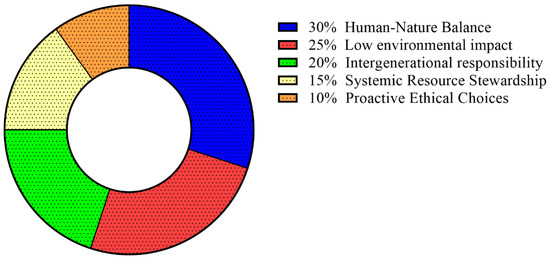
Figure 1.
Dominant themes in the students’ definitions of sustainability.
Although no students explicitly referenced the concept of planetary boundaries, 62 percent of the responses implicitly aligned with at least one boundary-related theme, especially those concerning production and consumption dynamics and ecosystem integrity. The frequent use of regenerative metaphors, such as “the planet can heal”, suggests that students intuitively perceive sustainability as a form of dynamic equilibrium. This interpretation aligns with previous findings rooted in eco-centric educational frameworks. However, the limited presence of socio-economic dimensions, such as equity or social justice, in the students’ responses highlights the need for pedagogical approaches that more explicitly connect ecological concepts with justice-oriented perspectives as already observed by Smaniotto and coauthors [19].
The students demonstrated moderate awareness of the food production’s environmental impact in preliminary assessments. Approximately 37% accurately identified that global food systems contribute to one-third of total greenhouse gas emissions, with another 42% conservatively estimating one-fifth. Knowledge gaps emerged regarding agricultural output allocation: while 71% correctly recognized plant-based foods as lower-emission alternatives to animal products, only 50% knew that merely 10% of plant production is directly consumed by humans. Estimates of European food waste varied, with half of students correctly citing one-fifth of total production, while 32% overestimated at one-third.
Post-intervention evaluations revealed significant cognitive and affective gains. Participants rated their overall project experience positively (7.95 ± 1.69 on a 10-point scale) (Figure 2C), with particularly high scores regarding the interest aroused by the topics covered (8.16 ± 1.69) (Figure 2A) and knowledge retention (7.53 ± 1.63) (Figure 2B). However, self-reported lifestyle changes showed more modest shifts (5.03 ± 2.31) (Figure 2D), suggesting that while behavioral modifications remain incremental, the intervention successfully enhanced environmental consciousness.
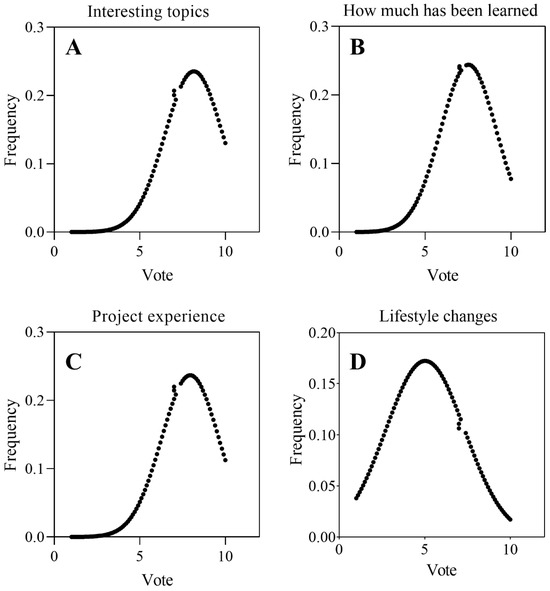
Figure 2.
(A–C) Student post-intervention evaluation of the project. (D) Self-reported lifestyle changes.
Overall, according to the results, the project was a path of growth and discovery having a positive impact on the students’ awareness and behaviour related to sustainable food choices.
3.2. Shifting Perspectives on Sustainable Dietary Practices
Most students identified as omnivores both before and after the project (Figure 3A). Although there was a slight increase in flexitarian and vegan responses post-project, this shift did not reach statistical significance (p = 0.0960). Remarkably, 26% of the students either changed or indicated a willingness to change their diet as a result of the project. At its outset, only 11% believed that their dietary habits would change, while 68% were unsure and 21% expected no change. The before-and-after comparison is highly significant (p < 0.0001), demonstrating a substantial impact of the project on the students’ choices (Figure 3A). All students who modified their diet during the project reported an increased intake of plant-based protein products (such as tofu and seitan).
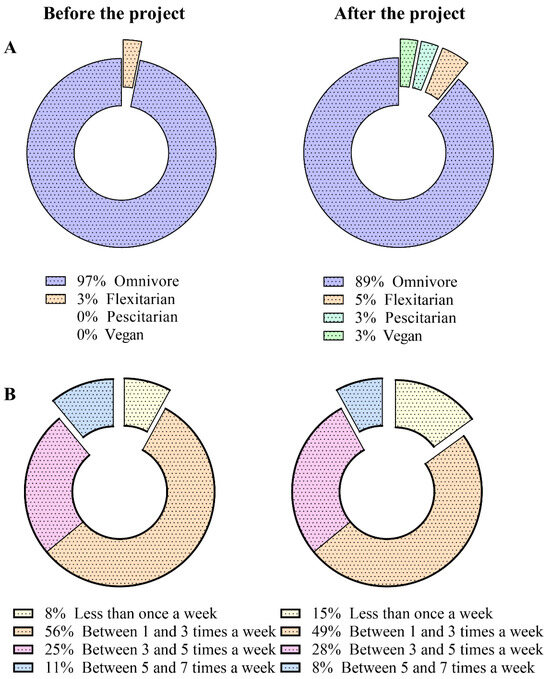
Figure 3.
(A) Student dietary regime before and after the project. (B) Student red meat consumption before and after the project.
Regarding protein sources, meat remained the primary choice, with vegan alternatives consumed by only 14% of participants at baseline. However, by the end of the project, the proportion of students consuming vegan alternatives nearly doubled to 26% (p = 0.0339). Neither the type of meat consumed (p = 0.0602) nor the frequency of red-meat consumption (p = 0.3784) changed significantly, although there was a modest trend toward increased white-meat preference and a slight reduction in overall meat intake per week (from 2.82 times per week to 2.66 times per week) (Figure 3B).
Consumption of novel protein sources such as algae and insects rose markedly (Figure 4): both showed significant increases in “tried at least once” rates (p < 0.0001 for each). An increased willingness to try novel food products reflect a shift toward more environmentally conscious dietary practices.

Figure 4.
Student consumption of novel protein sources before and after the project.
At project conclusion, 38% of students had sampled both algae and insects, compared to only 5% and 11%, respectively, at baseline. Before the project, only 11% were unsure if they had ever eaten insects, versus 32% for algae. This discrepancy may reflect sociocultural factors—entomophagy has been heavily debated in public forums and covered by social media, whereas algae, despite widespread use in supplements and Asian cuisines (e.g., nori in sushi), are less often recognized as such. For example, Spirulina (Arthrospira platensis) is the world’s most produced and consumed microalga, yet food labels frequently highlight “plant-based protein” without naming algae explicitly, making the term “algae” less common in food marketing than “insect.”
The results also underscore that cultural and psychological barriers can be effectively addressed through educational and experiential interventions targeted at younger generations.
3.3. Student Interviews: Was the Learning Experience Transformative?
Here are some insights shared by students who participated in the project:
- (1)
- Taking part in the project was a wonderful experience that allowed me to discover new foods that are incredibly nutritious for humans; it was truly beautiful because we had the opportunity to closely observe how young university students work inside the laboratories.
- (2)
- I think it was truly helpful in understanding what I would like to do in the future. It offered me a perspective on career paths I never expected to learn about, and above all, it addressed a topic that concerns the future of all humanity.
- (3)
- It was a wonderful experience because it allowed us to engage in discussions both among ourselves as students and with university professors and students. So, from every point of view, it was a very educational and useful experience.
- (4)
- What struck me the most in this project were the seminars held by university professors. I believe it is very important to raise awareness about these new protein sources, because I think there is still lack of knowledge surrounding this topic. People are not fully aware of how important these alternatives to traditional food can be, and how they could represent an evolution in our nutritional culture.
- (5)
- The enthusiasm and passion of all the participants made this experience incredible. It increased my awareness of the finite nature of energy and material resources in the food sector, giving me a new perspective through more sustainable foods like crickets.
- (6)
- At first, I had doubts about the advantages insects could have compared to our traditional diet, but this project highlighted the benefits they offer over conventional meat. Honestly, I believe this is the future of humanity, and we should start breaking the stereotypes that we, as a society, continue to preserve. People are not aware of the real benefits these alternative foods can bring to our diet, making it much more diverse, rich, and environmentally friendly.
The students’ reflections reveal three key aspects that made this project particularly impactful. First, it stood out as a formative and engaging educational experience, thanks to the direct interaction with university professors and young researchers, as well as the opportunity to observe scientific research in action (quotes 1,3,4,5) (Figure 5 and Figure 6).
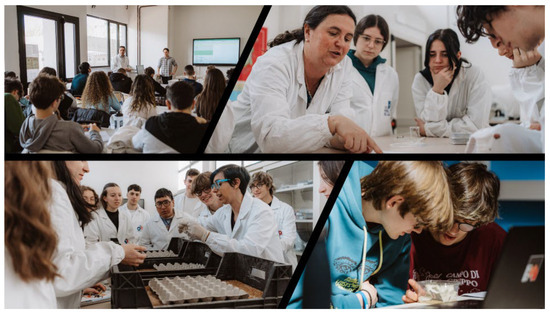
Figure 5.
In-class seminars and lessons.
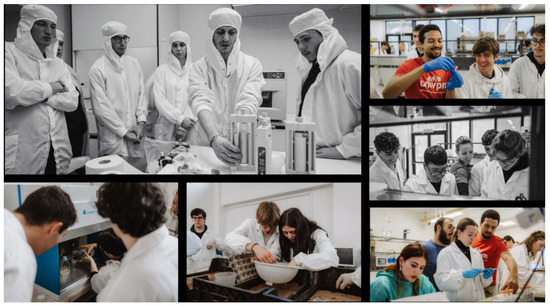
Figure 6.
Laboratory activities.
Second, the project served as a gateway to new perspectives on sustainable nutrition, especially through the exploration of alternative protein sources like insects, which challenged cultural stereotypes and opened up discussions on the future of food (quotes 5,6). Finally, it had a strong personal and social resonance, helping students reflect on their future career paths while raising awareness about the environmental and resource-related challenges facing humanity (quotes 2,4,5).
These insights underscore the value of participatory educational approaches that actively involve students in the learning process, particularly within the framework of effective Education for Sustainable Development (ESD) in secondary schools. The project also broadened the students’ understanding of global issues through the lenses of sustainability and innovation. Strengthening the connection between research, education, and the university’s third mission can generate deeper and more lasting societal impact. In this case, the project extended its reach through public events (Figure 7), engagement with families, primary schools, and local communities, and by addressing cultural barriers to the acceptance of novel foods. Ultimately, empowering students to become agents of change in their own lives and communities is a crucial step toward building a more sustainable future.
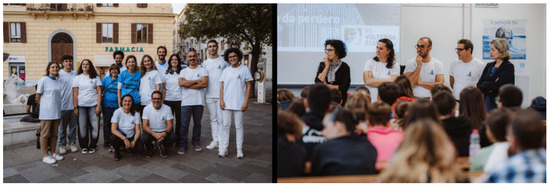
Figure 7.
Participation in public events.
4. Transformative Potential and Future Directions
Italy has introduced several reforms in research and education to promote sustainability, encouraging interdisciplinary approaches and rewarding practical impact. Notably, it became the first country to mandate the cross-disciplinary study of sustainable development across all schools nationwide [18]. In this framework, the present work was designed as a pilot educational project to evaluate its potential for broader implementation across the whole school and beyond. To this end, we initially involved two classes, a limited number of participants. We believe its strategic approach offers a compelling, scalable, and replicable model for integrating sustainability into school curricula and fostering environmental awareness and behavioural change among younger generations.
Moreover, the approach we used can also be valuable in the planetary health education, still in its infancy [16]. Indeed, while sustainability encompasses a broad framework aimed at balancing environmental, social, and economic systems for long-term viability, planetary health specifically focuses on the interdependence between human health and the health of Earth’s natural systems, emphasizing the consequences of environmental degradation on human well-being.
While the search for sustainable novel foods and food systems may appear more naturally suited to hotel-management vocational curricula [25], the global framework and sustainability competencies the present project introduces are increasingly essential for all young people, regardless of their educational pathway. Indeed, as stated by Smaniotto and coauthors [19], one of the challenges is the lack of sustainability literacy, which is considered as a set of skills, attitudes, competencies, dispositions, and values that a person possesses and that can be fostered and adapted through active learning so that people are enabled to participate in sustainable practices.
Notably, some participants indicated efforts to modify their family’s eating habits, reflecting an extension of the project’s impact beyond the classroom. This finding suggests that engaging younger generations can serve as an effective conduit for influencing the dietary behaviours of the caregiving generation (those typically responsible for food purchasing and preparation at home) who are often more resistant to adopting new eating habits. Indeed, while caregivers are traditionally seen as the primary influencers of children’s diets, emerging evidence suggests that the reverse dynamic is also possible, particularly among secondary school pupils. Adolescents can act as agents of change within households, encouraging shifts toward more sustainable and health-conscious dietary patterns. Age-related resistance to novel foods—particularly insects in a country with no cultural exposure such as Italy—can be mitigated through key drivers such as familiarity or prior experience, information about environmental and health benefits, and technological aspects [21]. These factors are often introduced within the family context by teenagers, who play a pivotal role in shaping attitudes toward such foods.
Lastly, the project exemplifies a successful collaboration between higher education and secondary schools, illustrating how the active engagement of a university in sustainability research and education can foster a virtuous regional ecosystem. Within such a context, secondary schools benefit from increased awareness, specialized expertise, and institutional support, which in turn facilitates the development of pedagogical tools and targeted teacher training initiatives. Notably, teacher training is among the key actions identified in 2017 by the Italian National Plan for Education for Sustainability [26] as essential for embedding sustainability into educational contexts [19].
5. Conclusions
This project demonstrates that targeted educational interventions can effectively influence students’ dietary awareness and openness to sustainable food alternatives. Experiential learning has the potential to foster sustainable behaviours in youths by bridging the gap between theoretical knowledge and practical application in everyday life.
The integration of ESD into secondary education for social innovation and transformation enables interdisciplinary projects to meaningfully connect learners with the complex challenges of planetary health.
Supplementary Materials
The following supporting information can be downloaded at: https://www.mdpi.com/article/10.3390/challe16040053/s1, Informed consent for participation, Pre-questionnaire (administered to Lyceum and Tech institute participants), and Post-questionnaire (administered to Lyceum and Tech institute participants).
Author Contributions
Conceptualization, A.N., C.T., I.B. and M.P.; Formal analysis, L.M. (Lorenzo Mollo), F.G. and B.A.; Investigation, A.N., C.T., C.G., A.A., S.I., A.P., L.M. (Lorenzo Mollo), G.S., M.M., L.M. (Lorenzo Massi), B.A., M.F., G.D., M.P. and R.M.; Methodology, A.N., C.T., L.M. (Lorenzo Mollo) and I.B.; Project administration, M.P. and R.M.; Resources, A.N., C.T., M.P. and R.M.; Visualization, A.P.; Writing—original draft, A.N. and L.M. (Lorenzo Mollo); Writing—review and editing, A.N., C.T., L.M. (Lorenzo Mollo), M.M., F.G., B.A., I.B. and M.P. All authors have read and agreed to the published version of the manuscript.
Funding
This research was funded by Fondazione Cariverona, call Format 2023, project number 53845, entitled “Cosa cuciniamo domani? Esperienze che alimentano il futuro”.
Institutional Review Board Statement
The study was conducted in accordance with the Declaration of Helsinki and approved by the Fondazione Cariverona (code 53845, 12 June 2023).
Informed Consent Statement
Informed consent for participation was obtained from all subjects involved in the study.
Data Availability Statement
Data will be made available on request.
Acknowledgments
We would like to thank Fondazione Cariverona (Format 2023 call) for funding the project, and UNIVPM for its co-funding support. Our gratitude also goes to Nutrinsect and Mulino Tre Ponti for their valuable participation in the project through the sharing of knowledge, staff, and resources. Special thanks to all the students, teachers and professors involved in the activities at IISVE. We deeply appreciate the dedication and professionalism of Mattia Muccichini for the outstanding photos and videos provided throughout the entire project.
Conflicts of Interest
Author Irene Biancarosa was employed by the company Nutrinsect SRL. The remaining authors declare that the research was conducted in the absence of any commercial or financial relationships that could be construed as a potential conflict of interest.
References
- Feeding the future global population. Nat. Commun. 2024, 15, 222. [CrossRef]
- United Nations. Transforming Our World: The 2030 Agenda for Sustainable Development. 2015. Available online: https://sdgs.un.org/2030agenda (accessed on 25 July 2025).
- Arora, N.K.; Mishra, I. Responsible consumption and production: A roadmap to sustainable development. Environ. Sustain. 2023, 6, 1–6. [Google Scholar] [CrossRef]
- Baena-Morales, S.; Fröberg, A. Towards a more sustainable future: Simple recommendations to integrate planetary health into education. Lancet Planet. Health 2023, 7, e868–e873. [Google Scholar] [CrossRef] [PubMed]
- Portuguez Castro, M.; Gómez Zermeño, M.G. Challenge based learning: Innovative pedagogy for sustainability through e-learning in higher education. Sustainability 2020, 12, 4063. [Google Scholar] [CrossRef]
- Baena-Morales, S.; González-Víllora, S. Physical education for sustainable development goals: Reflections and comments for contribution in the educational framework. Sport. Educ. Soc. 2023, 28, 697–713. [Google Scholar] [CrossRef]
- Rockström, J.; Steffen, W.; Noone, K.; Persson, A.; Chapin, F.S., 3rd; Lambin, E.F.; Lenton, T.M.; Scheffer, M.; Folke, C.; Schellnhuber, H.J.; et al. A safe operating space for humanity. Nature 2009, 461, 472–475. [Google Scholar] [CrossRef] [PubMed]
- Springmann, M.; Clark, M.; Mason-D’Croz, D.; Wiebe, K.; Bodirsky, B.L.; Lassaletta, L.; de Vries, W.; Vermeulen, S.J.; Herrero, M.; Carlson, K.M.; et al. Options for keeping the food system within environmental limits. Nature 2018, 562, 519–525. [Google Scholar] [CrossRef]
- UNESCO. Education for Sustainable Development: What You Need to Know. 2024. Available online: https://www.unesco.org/en/sustainable-development/education/need-know (accessed on 25 July 2025).
- Barth, M.; Godemann, J.; Rieckmann, M.; Stoltenberg, U. Developing key competencies for sustainable development in higher education. Int. J. Sustain. High. Educ. 2007, 8, 416–430. [Google Scholar] [CrossRef]
- Adomßent, M.; Hoffmann, T. The Concept of Competencies in the Context of Education for Sustainable Development (ESD). 2013. Available online: https://ges.engagement-global.de/files/2_Mediathek/Mediathek_Microsites/OR-Schulprogramm/Downloads/Unterrichtsmaterialien_beispiele/07-2-Concept-Paper-Adomssent-Hoffmann-final.pdf (accessed on 25 July 2025).
- Radwan, A.F.; Khalil, E.M.A.S. Knowledge, attitude and practice toward sustainability among university students in UAE. Int. J. Sustain. High. Educ. 2021, 22, 964–981. [Google Scholar] [CrossRef]
- Sposab, K.; Rieckmann, M. Development of Sustainability Competencies in Secondary School Education: A Scoping Literature Review. Sustainability 2024, 16, 10228. [Google Scholar] [CrossRef]
- Weiss, M.; Barth, M. Global research landscape of sustainability curricula implementation in higher education. Int. J. Sustain. High. Educ. 2019, 20, 570–589. [Google Scholar] [CrossRef]
- Serafini, P.G.; de Moura, J.M.; de Almeida, M.R.; de Rezende, J.F.D. Sustainable Development Goals in Higher Education Institutions: A systematic literature review. J. Clean. Prod. 2022, 370, 133473. [Google Scholar] [CrossRef]
- de Melo, P.R.H.; Alves, P.V.; de Camargo, T.S. Planetary Health initiatives in rural education at a riverside school in Southern Amazonas, Brazil. Challenges 2023, 14, 50. [Google Scholar] [CrossRef]
- Rushton, E.A.C.; Walshe, N. Curriculum making and climate change and sustainability education: A case study of school teachers’ practices from England, UK. Environ. Educ. Res. 2025, 31, 1083–1097. [Google Scholar] [CrossRef]
- Fioramonti, L.; Giordano, C.; Basile, F.L. Fostering academic interdisciplinarity: Italy’s pioneering experiment on sustainability. Education in Schools and Universities. Front. Sustain. 2021, 2, 631610. [Google Scholar] [CrossRef]
- Smaniotto, C.; Saramin, A.; Brunelli, L.; Parpinel, M. Insights and next challenges for the italian educational system to teach sustainability in a global context. Sustainability 2023, 15, 209. [Google Scholar] [CrossRef]
- Melis, C.; Borg, F.; Falcicchio, G. Sustainability in early childhood education: A comparison among national curricula in Italy, Norway and Sweden. Environ. Educ. Res. 2025, 17, 7136. [Google Scholar] [CrossRef]
- Laureati, M.; De Boni, A.; Saba, A.; Lamy, E.; Minervini, F.; Delgado, A.M.; Sinesio, F. Determinants of Consumers’ Acceptance and Adoption of Novel Food in View of More Resilient and Sustainable Food Systems in the EU: A Systematic Literature Review. Foods 2024, 13, 1534. [Google Scholar] [CrossRef] [PubMed]
- Williamson, E.; Ross, I.L.; Wall, B.T.; Hankamer, B. Microalgae: Potential novel protein for sustainable human nutrition. Trends Plant Sci. 2024, 29, 370–382. [Google Scholar] [CrossRef] [PubMed]
- Grosso, G.; Fresán, U.; Bes-Rastrollo, M.; Marventano, S.; Galvano, F. Environmental Impact of Dietary Choices: Role of the Mediterranean and Other Dietary Patterns in an Italian Cohort. Int. J. Environ. Res. Public Health 2020, 17, 1468. [Google Scholar] [CrossRef]
- Ritchie, H.; Rosado, P.; Roser, M. Environmental Impacts of Food Production. 2022. Available online: https://ourworldindata.org/environmental-impacts-of-food (accessed on 25 July 2025).
- Pedrini, L.; Romito, M.; Domaneschi, L.; Navarini, G. Environmentality in (food) sustainability education: An analysis of a pedagogic intervention in Italy. Discourse Stud. Cult. Politics Educ. 2024, 46, 119–131. [Google Scholar] [CrossRef]
- MIUR. ASviS. Piano per L’Educazione Alla Sostenibilità. 2017. Available online: https://asvis.it/public/asvis/files/sostenibilita_slide_def.pdf (accessed on 17 September 2022).
Disclaimer/Publisher’s Note: The statements, opinions and data contained in all publications are solely those of the individual author(s) and contributor(s) and not of MDPI and/or the editor(s). MDPI and/or the editor(s) disclaim responsibility for any injury to people or property resulting from any ideas, methods, instructions or products referred to in the content. |
© 2025 by the authors. Licensee MDPI, Basel, Switzerland. This article is an open access article distributed under the terms and conditions of the Creative Commons Attribution (CC BY) license (https://creativecommons.org/licenses/by/4.0/).